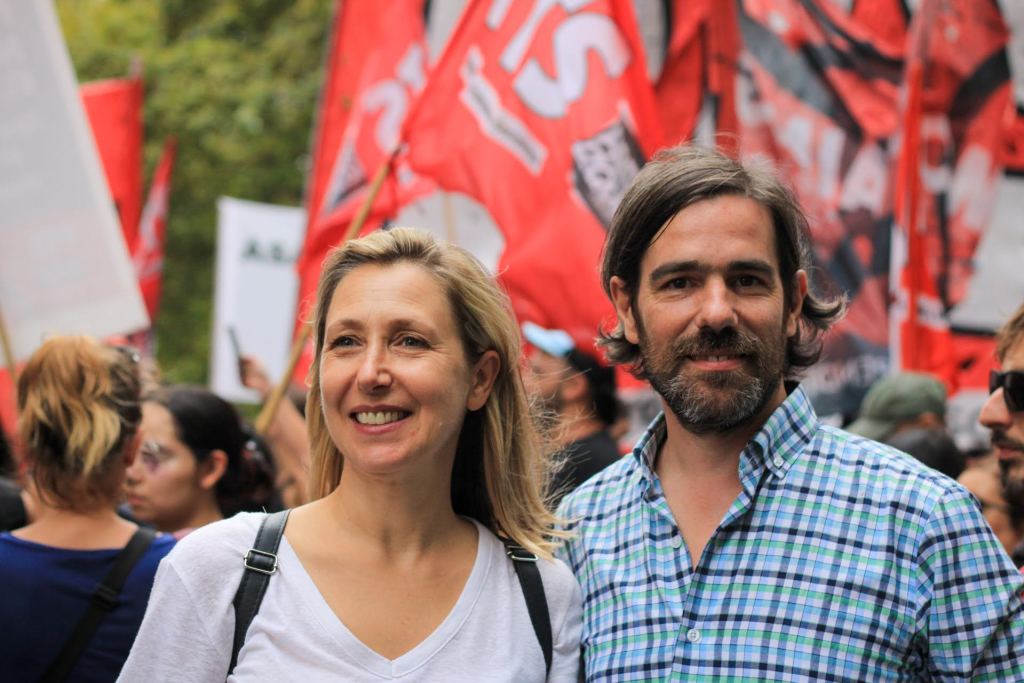By Martina Jaureguy & Amy Booth
Argentina’s main political forces are coalitions, rather than parties, which means they’re formed of several political parties joined together. As you can imagine, that means things can get complicated: coalitions can bring in new parties, split up, change their names, and change alliances between regional and national level. They’re also sometimes referred to as “political spaces”.
So, if a flurry of three-letter acronyms has you confused in campaign season, fear not: here’s the Herald’s guide to understanding Argentina’s political coalitions.
Who are Argentina’s main coalitions?
Unión por la Patria (UxP)

Seats in deputies: 118/257 (46%)
Seats in senate: 31/72 (43%)
This is the current ruling coalition. It was called Frente de Todos from 2019 until June, when the leaders of the member parties adopted their current name. It is common for Argentina’s coalitions to change their names ahead of elections.
It’s had three different names so far: Frente para la Victoria (2003-2019), Unidad Ciudadana (2017-2019) and Frente de Todos (2019-2023).
While it functions as a coalition, it is made up of parties born from the Partido Justicialista, or, as it’s known in Argentina, Peronism.
The different peronist parties in Unión por la Patria are:
Partido Justicialista
This is one of the two main national parties. It is the largest party in UxP, with 91 of its 118 deputies. It was founded by Juan Domingo Perón in 1946, which is why it is considered the main Peronist party. Prominent Justicialista members include President Alberto Fernández, Vice President Cristina Fernández de Kirchner, Chief of Staff Agustín Rossi, Interior Minister Eduardo “Wado” de Pedro, and other key members of the cabinet.
They have a close relationship with trade unions and social movements. They advocate for Argentina’s sovereignty and economic independence from the Global North with a focus on national production. They often back Big Government and welfare state policies.
Frente Renovador
Economy Minister and UxP presidential candidate Sergio Massa is the founder and leader of Frente Renovador, which is sometimes translated as Renovation Front or Renewal Front. Nine of UxP’s 118 deputies are from Frente Renovador. Massa joined Unión por la Patria — known at the time as Unidad Ciudadana — ahead of the 2019 presidential elections.
The party identifies as peronist. Since its foundation, it has sought to distinguish itself from kirchnerism, but the two political movements broadly share the same values. Massa, who was Chief of Staff during Cristina Kirchner’s first term, founded the party in 2013 to campaign against kirchnerism during that year’s legislative elections.
Frente Patria Grande
Founded in 2018, it represents left-wing Peronism, with presidential candidate Juan Grabois as its main leader. While the larger peronist parties decided to back Massa and Rossi as their presidential ticket, Grabois decided to run to oppose Massa’s more centrist ideas. “Land, roof and jobs” is the party’s main slogan. It has three deputies in Congress. Their exponents come from social and student movements, precarious and informal workers’ movements known as the popular economy, and activists who work in poor neighborhoods.
Other parties
There are a total of 17 parties in UxP, ranging from far-left parties such as the Partido Comunista Revolucionario to the right-wing Partido Conservador. Most are small, and some have no deputies or senators at all. The only presidential candidates are Massa and Grabois.
Juntos por el Cambio (JxC)

Seats in deputies: 116/257 (45%)
Seats in senate: 31/72 (43%)
Founded in 2015, it’s the main opposition coalition. It was called Cambiemos until June 2019. JxC’s founders were PRO leader Mauricio Macri, Coalición Cívica founder Elisa Carrió and Ernesto Sanz, who was the UCR’s president at the time. This year, libertarian economist José Luis Espert joined JxC.
Propuesta Republicana (PRO)
This is one of the main parties in the coalition, alongside the Unión Cívica Radical (UCR). It has 48 deputies and 9 senators in Congress.
Prominent members include Buenos Aires city Mayor Horacio Rodríguez Larreta, former Security Minister Patricia Bullrich, and former President Macri. Larreta and Bullrich are internal rivals for the JxC presidential nomination.
PRO, founded in 2005, has been the ruling party in Buenos Aires city since 2007, when Mauricio Macri became mayor. Larreta replaced him in 2015. They advocate for a free market economy, a small state, and tough crime policies, with a broadly conservative stance on social issues.
Unión Cívica Radical (UCR)
Founded in 1891, the UCR is the oldest party in Argentina and one of the two national parties (along with PJ). Its members are known as radicales, and they have 34 deputies and 18 senators in Congress.
Originally, the UCR advocated for a free and open democracy in which all citizens were treated equally and everyone could vote, regardless of their economic and social status. At the beginning of the 20th century, only a select group of rich and powerful men were allowed to vote.
Often described as centrist, some Radicales share some stances with Peronism, such as the defense of sovereignty and social justice. However, others have a more conservative stance.
Radicales in front line politics during these elections include Jujuy Governor Gerardo Morales, Larreta’s vice presidential candidate; Luis Petri, Bullrich’s vice presidential candidate; and Martín Lousteau, who is running for BA city mayor against PRO’s Jorge Macri.
Coalición Cívica (CC)
Founded by Elisa Carrió in 2002, during the economic and social crisis that exploded in 2001. They currently have 11 deputies and no senators. Within the JxC, it’s the most centrist party in a broadly right-wing coalition. While they are members of JxC, Carrió has criticized Macri’s austerity policies in the past.
Others
Other parties within JxC include Encuentro Republicano Federal, led by former Justicialista Miguel Ángel Pichetto, and Avanza Libertad, led by libertarian former ally of Milei, José Luis Espert.
Who else is in the picture?
La Libertad Avanza (LLA)

Ultra right-wing libertarian economist Javier Milei, of coalition La Libertad Avanza, is coming third in the presidential race after JxC and UxP, according to most polls. However, very few members of his coalition stand to gain elected office, which means it is unclear how he would govern if he were to win the presidency. He and lawyer Victoria Villarruel are the only LLA deputies in Congress, and they have no senators. None of LLA’s candidates have won governorships in any of the provincial elections this year so far.
LLA advocates for a completely unregulated free market, with almost no state presence, which includes rejecting minimum wage legislation and all forms of state welfare. They have a strong conservative stance on social issues such as abortion. Villarruel has been accused of denying the crimes against humanity committed by the last dictatorship.
Frente de Izquierda (FIT)

This small Trotskyist coalition in Argentina currently has four deputies: Romina del Plá, Alejandro Vilca, and the presidential and vice presidential candidates Myriam Bregman and Nicolás del Caño. While small, it’s still a coalition, made up of the Partido Obrero, Partido de los Trabajadores Socialistas, Izquierda Socialista, and the Movimiento Socialista de los Trabajadores. They advocate for nationalizing banks, giving workers control of utility companies, and lowering public officials’ incomes. They are vocal opponents of paying the IMF debt.
Why do coalitions keep changing their names?
Coalitions change their names to “leave behind the name that reminds voters of failures in the current government,” said Dr Mariano Fraschini, a politics lecturer at the University of Buenos Aires and the Latin American Faculty of Social Sciences. “Frente de Todos [now Unión por la Patria] and Cambiemos [now Juntos por el Cambio] did it. Keeping the same name may lead to voters not being motivated to vote for them.”
What about the provincial parties?
Some parties exist only at provincial level. Nonetheless, they often command significant support. They may or may not be allied with the national coalitions. In some cases, parties that belong to different coalitions at national level work together at provincial level.
There are also associations between provincial parties, like SER, which has two deputies in Congress, one from La Rioja and the other from Santa Cruz.
Many provinces hold their governor or mayor elections at a different time from the national elections, depending on what the ruling authorities consider more convenient for their party.
“The province’s electors vote with a provincial mindset,” Fraschini said. “They vote for the candidates that are from that province, and they don’t like it when porteños get in the way. That’s why many provincial elections happen on different dates from the national one.




